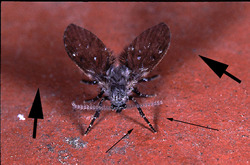
Ringlights

One of the most frequently asked questions over the years has been why I don’t endorse the use of ring flashes. I guess people keep asking because these are supposed to be a macro standard equipment and they see nothing here about them. Well, I never used ring flashes because I didn’t like their output. They are designed to produce a flat, shadowless lightning which is very convenient for coins, stamps and that kind of stuff, not in my opinion for animals. In nature there’s a strong light up there, thanks to the old Sun, and there are shadows also.
So I always try to have two light sources in my pictures, a strong one from above (mimicking the Sun) plus a weaker one somewhere laterally to fill the shadows and make the textures pop up. In macro I only use cloudy-day even lightning when shooting insects within wider landscapes; and then, ring flashes are useless because they are not powerful enough to reach the background. Actually, that’s the reason for these flashes to produce so often dark backgrounds.
Additionally, as they are placed so closely to the optical axis, ringflashes tend to produce nasty circular reflections on shiny subjects such as some beetles, or water drops. Furthermore, recent ringlights are not circular anymore, but rather two side-by-side bulbs, like the classical Nikon’s SB-21/29 series. A few brands give you 4 tubes by adding two more sources below and above the lens. Such a lightning is not uniform and shadowless anymore, but there’s a tendency to produce symmetrical double shadows, which are the ugliest thing you could put in an image. See below an example of this issue.
Thus, instead of using a ring flash, I feel much better using 2 separate flashes mounted on a good bracket, that will allow shadowless lighting, should I want it, plus many other lighting options, at a much lower price; and enjoying more available power. Actually, real ring flashes have disappeared almost completely. A leap ahead has been made with the modern macro lighting systems like Nikon’s SB-200 units (and Canon counterparts) as they give much more flexibility since you can use any number of light sources you wish, which can be moved around your lens -albeit in a limited way. They are more convenient but also limited in power, so that thay must be kept close to the subject; however, versatility is high as they can be controlled with the in-built flash of several Nikon cameras, getting rid of any wiring, and can also be smoothly combined to regular flashes. This also allows using them as tiny portable, put-them-anywhere light sources.
This also allows using them as tiny portable, put-them-anywhere light sources.
Another interesting option are the LED ringlights used for microscopy lighting. They include a variable number of LED lamps (from 24 to more than 100) evenly distributed around a circular support, in a similar way that of the primitive circular flash bulbs. Inner diameter is usually close to most photo lenses so that they can be easily adapted. As most models are not battery-operated, however, they are restricted to the studio use. They can be controlled in output light intensity via a dimmer on the power source; some units even have separate controls for selectively dimming quarter-circle zones. These devices are interesting as they allow result previewing, do not emit heat, and can be easily compensated by color temperature in camera. The dead tick image  was made using one of these units. Although it may probably be cheaper to build yourself your rig using a microscope part, some photography-oriented models are showing up in commerce, such as this one by Manfrotto.
was made using one of these units. Although it may probably be cheaper to build yourself your rig using a microscope part, some photography-oriented models are showing up in commerce, such as this one by Manfrotto.
← Romeo y Regleta Focas en la niebla →



